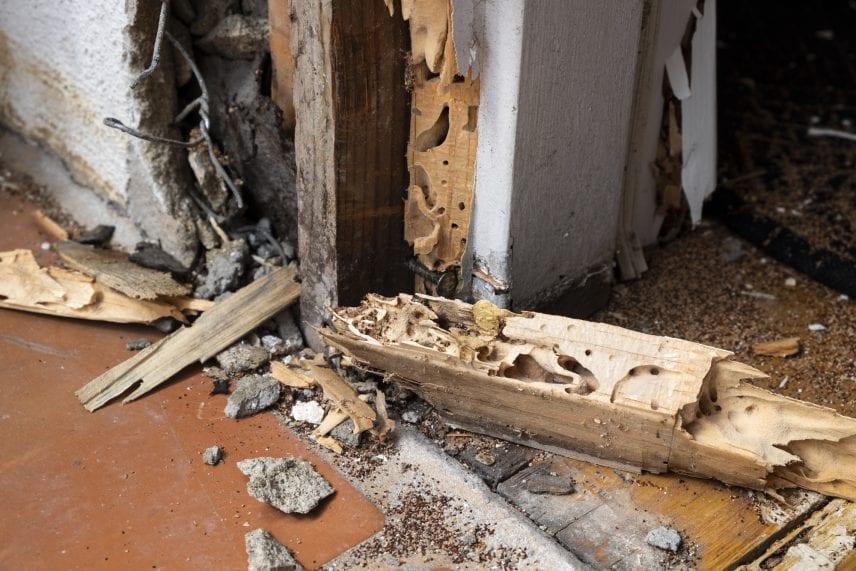The U.S Department of Agriculture predicts that termites cause over a billion dollars of damage to homes in America every year.
No homeowner wants to discover a colony of termites in their property because of the havoc they can cause. Because of this, you must know the telltale signs of termites so you can take immediate action.
Not sure what they are? Don’t worry, you’ve come to the right place. Here are five signs of termites.
What Are Termites?
You may wonder “what do termites look like?”
Termites are small and look similar to ants which can be confusing. These pests are around 1/4 to 1/2 of an inch long, with straight bodies, and antennae. There are 40 different species, termites range from white to light brown.
If you see insects that look like white ants, it’s likely they’re worker termites, the largest population out of the termite colony.
A termite’s diet consists of deadwood and decaying plant material potentially including your home, which could cost you thousands.
The 5 Signs of Termites
There are five signs of termites at home so be on the lookout. Once you notice anything unfamiliar, contact pest control so they can act accordingly.
Consider these signs, for example:
1. Noise Inside Walls
You may notice clicking sounds coming from your walls. It’s likely soldier termites who bang their head against the wood to signal danger to the other termites.
Also, worker termites are loud eaters so if you’re suspicious, press your ear close to the wood to hear them.
2. Flying Termites
One of the earliest signs of a termite infestation is when flying termites (known as swarmers or alates) appear. These termites are the males and females who find a mate so they could establish a new colony potentially in your home.
When they land, the termites intentionally twist their wings off because they’ll never need them again.
This means you should check your window sills, decks, or patios for discarded wings as it means termites are nearby. As soon as you spot them, call a professional so they can do termite treatment on your home.
You should also check for frass (or termite droppings). This is a sign of dry wood termites as they push their faces out of small holes near the entrances of the nests.
As a result, they leave behind little black marks and a dark substance around the area.
3. Hollow or Damaged Wood
If you’re looking for signs of termite damage, look out for hollow wood. This is caused by drywood termites chewing through the wood to find cellulose. Eventually, these grooves weaken the wood which results in costly structural damage.
Knock on the area you think has termite damage and it’ll sound hollow because the timber from the inside has been eaten away. Meanwhile, subterranean termites eat along the grain which creates a honeycomb pattern in the wood.
You should also check whether there are blisters in your wood flooring. This is because subterranean termites have damaged your subfloor which looks similar to water damage.
Plus, check for uneven or bubbling paint as it’s often a sign of moisture build-up which is either water damage or termites.
Don’t forget your garden timber as it’s at risk of a termite infection too. Check your veranda, deck, and fence posts as they’re all food sources for termites.
If you notice evidence of termite activity, don’t delay, because you don’t want to risk attracting more termites into your home.
4. Hard-to-Open Windows and Doors
Test whether your windows and doors are stiff. Occasionally it’s signs of damp weather but it could also be termites.
Termites produce moisture when they chew and tunnel through door or window frames, causing them to warp. As a result, it’s difficult to open or close them.
You should examine your garage door’s frame for holes. Chew marks will likely appear where the door touches the cement or brick. Take a hammer and tap against the wood to see if it’s hollow.
If your property has wood siding, you may notice chew marks nearer the soil or several holes. Because of this, you must clear ground cover that’s made from organic material like dead leaves or mulch as it’s where termites thrive.
5. Mud Shelter Tubes
Go outside and look out for pencil-sized mud tubes near your foundation or shed. These are the work of subterranean termites that nest underground and then burrow their way towards their food source, often a house structure.
Termites require a specific temperature and humidity level to survive and use these tunnels to block out cool air, thereby turning your home into an environment they can thrive.
You should also check your backyard for potential damage. For instance, you may have trees which means they could be heading towards your home.
A clear indicator that your tree has termites is if there are small holes and wood shavings where they have burrowed into the tree. Evaluate the base and use a shovel to dig around the roots.
Although it’s difficult to measure the amount of damage, some termites build nests on the branches or trunk of a tree. Because of this, you may also see discarded wings or dead termites. Either way, it’s time to call a professional.
These Are the Main Signs of Termites
Now you know the five main signs of termites. Notice if you hear unfamiliar sounds coming from your walls, whether there are discarded wings, and if there are mud tubes appearing around your home.
If yes, you must take action immediately otherwise it could cost you a fortune in structural repair.
Are you worried you have a termite problem? If so, we’d love to help. Contact us here for more details.


